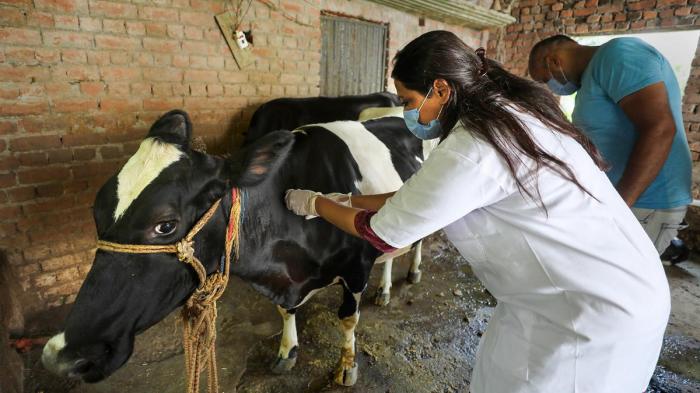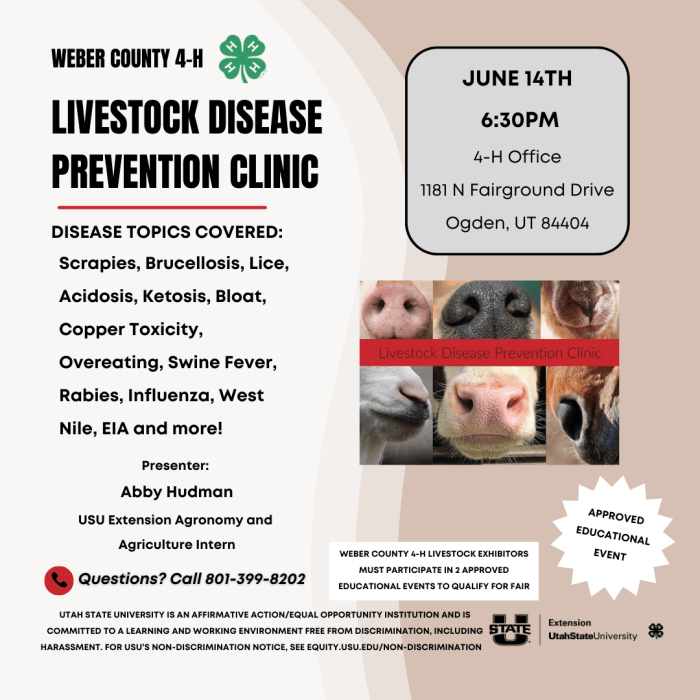
Livestock health and disease prevention sets the stage for this enthralling narrative, offering readers a glimpse into a story that is rich in detail with entertaining interactive style and brimming with originality from the outset.
From discussing common diseases to exploring vaccination programs and nutrition, this guide covers all aspects of maintaining livestock health.
Livestock Health and Disease Prevention
Livestock are susceptible to various diseases that can impact their health and productivity. It is essential for livestock owners to be aware of common diseases affecting their animals and take preventive measures to ensure their well-being. Regular veterinary check-ups and proper health management practices are key in maintaining optimal health in livestock.
Common Diseases Affecting Livestock
- Foot and Mouth Disease: Highly contagious viral disease affecting cloven-hoofed animals, causing fever, blisters, and lameness.
- Blackleg: Bacterial infection affecting cattle and sheep, leading to sudden death and swelling in affected areas.
- Mastitis: Inflammation of the udder in dairy cows, caused by bacteria, leading to decreased milk production and quality.
Preventive Measures for Livestock Diseases
- Implement biosecurity measures to prevent the introduction and spread of diseases on the farm.
- Vaccinate animals against common diseases based on veterinary recommendations.
- Maintain clean and hygienic living conditions for livestock to reduce the risk of infections.
Importance of Regular Veterinary Check-ups
Regular veterinary check-ups are crucial for early detection of diseases and timely intervention to prevent outbreaks. Veterinarians can provide guidance on nutrition, vaccination schedules, and overall health management practices.
Strategies for Maintaining Optimal Health in Livestock
- Provide a balanced diet tailored to the specific nutritional needs of each type of livestock.
- Ensure access to clean water at all times to prevent dehydration and promote proper digestion.
- Monitor livestock behavior and health indicators regularly to detect any signs of illness or distress.
Livestock Vaccinations

Vaccinations play a crucial role in preventing diseases and promoting the overall health of livestock. By following a proper vaccination schedule, farmers can protect their animals from a variety of illnesses, ensuring a higher quality of life and productivity for the herd.
Essential Vaccinations for Livestock
- Cattle: Essential vaccinations for cattle include vaccines against diseases such as blackleg, infectious bovine rhinotracheitis, and bovine viral diarrhea.
- Poultry: Poultry require vaccinations against diseases like Newcastle disease, infectious bronchitis, and Marek’s disease.
- Sheep and Goats: Common vaccinations for sheep and goats include protection against diseases such as clostridial infections and caseous lymphadenitis.
- Swine: Swine vaccinations typically include protection against diseases like porcine circovirus and swine influenza.
Vaccination Schedule for Livestock
- It is essential to consult with a veterinarian to establish a proper vaccination schedule based on the specific needs of the livestock.
- Vaccinations should be administered at the appropriate age and intervals to ensure maximum effectiveness.
- Regular booster shots may be necessary to maintain immunity levels over time.
Herd Immunity in Livestock
Vaccination not only protects individual animals but also contributes to the concept of herd immunity within livestock populations. This means that when a significant portion of the herd is immune to a disease, it helps prevent the spread of the illness, protecting even unvaccinated animals.
Successful Vaccination Programs in Livestock Farming
- In the poultry industry, successful vaccination programs have significantly reduced the incidence of diseases like Newcastle disease and infectious bronchitis, leading to improved flock health and productivity.
- In the cattle sector, vaccination against diseases such as blackleg has been instrumental in preventing outbreaks and minimizing economic losses for farmers.
- Collaboration between veterinarians, farmers, and vaccine manufacturers is essential for the success of vaccination programs in livestock farming.
Nutrition and Disease Prevention
Proper nutrition plays a crucial role in preventing diseases in livestock. A well-balanced diet can boost immunity, improve overall health, and help prevent common illnesses. Let’s dive into the details of how nutrition can be a key component in disease prevention for livestock.
Ideal Diet for Different Livestock
When it comes to different types of livestock, the ideal diet may vary based on their specific nutritional requirements. For example, cattle may require a diet high in fiber, while poultry may need a diet rich in protein. It is essential to understand the nutritional needs of each type of livestock to ensure they receive the proper nutrients to boost their immunity and prevent diseases.
- For cattle: A diet consisting of high-quality forage, grains, and mineral supplements can help support their immune system and prevent diseases such as respiratory infections.
- For poultry: A diet rich in protein, vitamins, and minerals is essential to support their immune system and prevent diseases like coccidiosis.
- For pigs: A balanced diet of grains, protein sources, and essential vitamins and minerals can help prevent diseases such as swine flu and porcine reproductive and respiratory syndrome.
It is important to work with a veterinarian or nutritionist to formulate a balanced diet tailored to the specific needs of each type of livestock.
Supplements for Livestock Health
In addition to a well-balanced diet, supplements can play a vital role in enhancing livestock health and disease resistance. Different supplements can provide additional nutrients that may be lacking in their regular diet, helping to fill nutritional gaps and boost immunity.
- Probiotics: These supplements can help maintain a healthy gut flora, improving digestion and overall health.
- Vitamin supplements: Providing additional vitamins, such as Vitamin C or Vitamin E, can help support the immune system and prevent diseases.
- Mineral supplements: Minerals like selenium and zinc are essential for immune function and disease prevention in livestock.
Tips for Formulating Balanced Diets
When formulating diets for livestock to prevent common illnesses, it is essential to consider the following tips:
- Ensure a proper balance of protein, carbohydrates, fats, vitamins, and minerals in their diet.
- Provide access to clean and fresh water at all times to support digestion and overall health.
- Avoid sudden changes in their diet, as this can lead to digestive issues and susceptibility to diseases.
- Monitor their body condition regularly and adjust their diet accordingly to meet their changing nutritional needs.
Hygiene Practices in Livestock Farming

Maintaining proper hygiene practices in livestock farming is crucial in preventing the spread of diseases among animals. A clean environment not only promotes the health and well-being of the livestock but also helps in ensuring the overall productivity of the farm. By implementing effective hygiene measures, farmers can significantly reduce the risk of disease outbreaks and improve the quality of their livestock.
Importance of Cleanliness in Preventing Diseases Among Livestock
- Regular cleaning and disinfection of livestock facilities can help in eliminating harmful pathogens that may cause diseases.
- Proper hygiene practices can prevent the transmission of diseases from one animal to another, reducing the chances of an outbreak.
- Clean and hygienic surroundings contribute to the overall health and well-being of the animals, leading to improved growth and productivity.
Guidelines for Maintaining a Hygienic Environment in Livestock Facilities
- Regularly clean and disinfect animal housing, feeding, and watering areas to prevent the buildup of pathogens.
- Implement biosecurity measures to control the entry of disease-causing agents into the farm premises.
- Properly manage manure and waste disposal to reduce environmental contamination and disease spread.
Proper Waste Management Practices to Minimize Disease Spread
- Dispose of animal waste in designated areas away from livestock facilities to prevent contamination.
- Compost manure properly to reduce the presence of pathogens and use it as organic fertilizer for crops.
- Regularly clean and maintain waste storage areas to prevent the breeding of disease vectors.
Success Stories of Farms that Prioritize Hygiene and Disease Prevention
- A farm in XYZ implemented strict hygiene protocols, resulting in a significant decrease in disease incidents among their livestock.
- By maintaining a clean environment and following proper waste management practices, Farm ABC saw an improvement in the overall health and productivity of their animals.
- Farm DEF’s commitment to hygiene practices not only prevented disease outbreaks but also enhanced the quality of their products, leading to increased profitability.
Animals, Livestock, Wild Animals
The interconnectedness between domestic animals, livestock, and wild animals plays a crucial role in disease transmission, posing risks to all populations involved. Zoonotic diseases, which can be transmitted between animals and humans, further complicate the situation by affecting livestock and wild animal populations alike. Conservation efforts are essential in preventing the spread of diseases between wild and domestic animals, with collaboration between wildlife reserves and livestock farms being key to effective disease prevention strategies.
Zoonotic Diseases and Impacts
Zoonotic diseases, such as Avian Influenza and Brucellosis, can have devastating impacts on both livestock and wild animal populations. These diseases not only threaten the health and well-being of animals but also pose risks to human health. It is crucial to implement robust disease prevention measures to safeguard the interconnected ecosystems and prevent outbreaks that can have far-reaching consequences.
- Avian Influenza: A highly contagious disease that can affect both domestic poultry and wild bird populations. The transmission of Avian Influenza between wild and domestic birds highlights the importance of coordinated efforts in disease surveillance and control.
- Brucellosis: An infectious disease that can be transmitted from livestock to wildlife, posing risks to species such as bison and elk. The impact of Brucellosis on wildlife populations underscores the need for collaborative approaches in disease management.
Conservation Efforts and Collaboration
Conservation efforts are vital in preventing the spread of diseases between wild and domestic animals, aiming to protect biodiversity and ecosystem health. Collaboration between wildlife reserves and livestock farms is essential in implementing proactive disease prevention strategies and fostering mutual understanding between stakeholders.
Collaborative approaches in disease prevention can enhance the resilience of both wild and domestic animal populations, contributing to the overall health of ecosystems.
- Disease Surveillance and Monitoring: Regular monitoring of disease prevalence in both wild and domestic animal populations is essential for early detection and effective control of potential outbreaks.
- Habitat Protection and Biosecurity Measures: Preserving natural habitats and implementing biosecurity measures in livestock farms can help minimize the risk of disease transmission between different animal populations.
- Research and Education Initiatives: Investing in research and education programs can enhance knowledge sharing and capacity building among stakeholders, fostering a culture of collaboration and innovation in disease prevention efforts.
Ending Remarks
As we conclude this journey into livestock health and disease prevention, remember that a proactive approach is key to ensuring the well-being of your animals. By implementing the strategies discussed, you can create a thriving environment for your livestock.
FAQs
What are some common diseases that affect livestock?
Common diseases include foot-and-mouth disease, brucellosis, and mastitis.
How often should I schedule veterinary check-ups for my livestock?
It is recommended to have regular check-ups at least once or twice a year.
What is the role of nutrition in preventing diseases in livestock?
Nutrition plays a crucial role in boosting immunity and preventing common illnesses.





